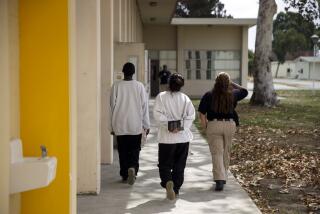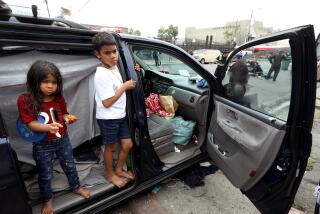Agreement on Day Laborer Site in Danger of Crumbling
Almost a year after the city of Glendale and representatives of Latino organizations struck an agreement on a gathering site for day laborers, the city’s strategy to keep the workers off the streets is in serious danger of falling apart.
The Catholic Youth Organization, which had volunteered its youth center on San Fernando Road as a pickup site, no longer welcomes the day laborers, and city officials are scrambling to find a new gathering spot.
The CYO closed its gates to the day laborers Monday when the two part-time employees hired to supervise the workers returned to school-related jobs, CYO Director Luisa Chavez said. The youth center had opened its grounds to the workers in September, 1988, to head off a hotly debated city ordinance that would have made it illegal to solicit work on public property. The ordinance was shelved.
Now, nearly 60 day laborers, most of them illegal immigrants, wait for work each day on a five-block stretch of San Fernando Road near the CYO. Another 20 to 30 have returned to the sidewalk in front of a paint store on Jackson Street and Broadway in the heart of the downtown commercial district--the unofficial pickup site until the workers moved to the CYO.
A solution to the crisis may be in the works.
Councilman Dick Jutras met Monday with the head of the Glendale chapter of the Salvation Army, who said his group is willing take over supervision of the day laborer program.
“If there is a need, we stand ready to help,” said Lt. Kenneth Hodder, the chapter’s commanding officer. “The discussions are at a very early stage, but we have indicated to the city our willingness to help in terms of administering the program.”
Glendale City Council members indicated that they would welcome the Salvation Army’s help.
“If they get a program working, that would be great,” Councilwoman Ginger Bremberg said. “Everything they do, they do wonderfully well.”
City Manager David Ramsay said the solution to the day laborer problem should come from the community, from private organizations such as the Salvation Army and the CYO, and that the city should not get heavily involved, financially or otherwise.
“This is a community problem that the city does not wish to own,” he said. “I don’t think it’s up to the cities to resolve an international economics problem.”
Locating a permanent gathering site for the workers remains a problem.
Chavez said she “doubts very much” that workers would be welcomed back to the CYO, even if new supervisors are hired. Since the day laborer program began, the CYO day-care program has suffered a drop of more than half its enrollment, Chavez said. Parents were afraid to leave their children at the center while dozens of workers packed the CYO parking lot, she said.
Fall Program
Next week, the CYO will begin its fall day-care program, and Chavez hopes that attendance will rise after the yearlong slump during the day laborers’ presence.
Hodder said the Salvation Army is equally unprepared to provide a pickup site. “We want to help, but we can’t do it here at the Salvation Army,” he said.
Ramsay said that the city’s search for a gathering site has been unsuccessful to date, but that he plans to “call a staff meeting in the next couple of weeks to see what options are available.”
More to Read
Sign up for Essential California
The most important California stories and recommendations in your inbox every morning.
You may occasionally receive promotional content from the Los Angeles Times.










